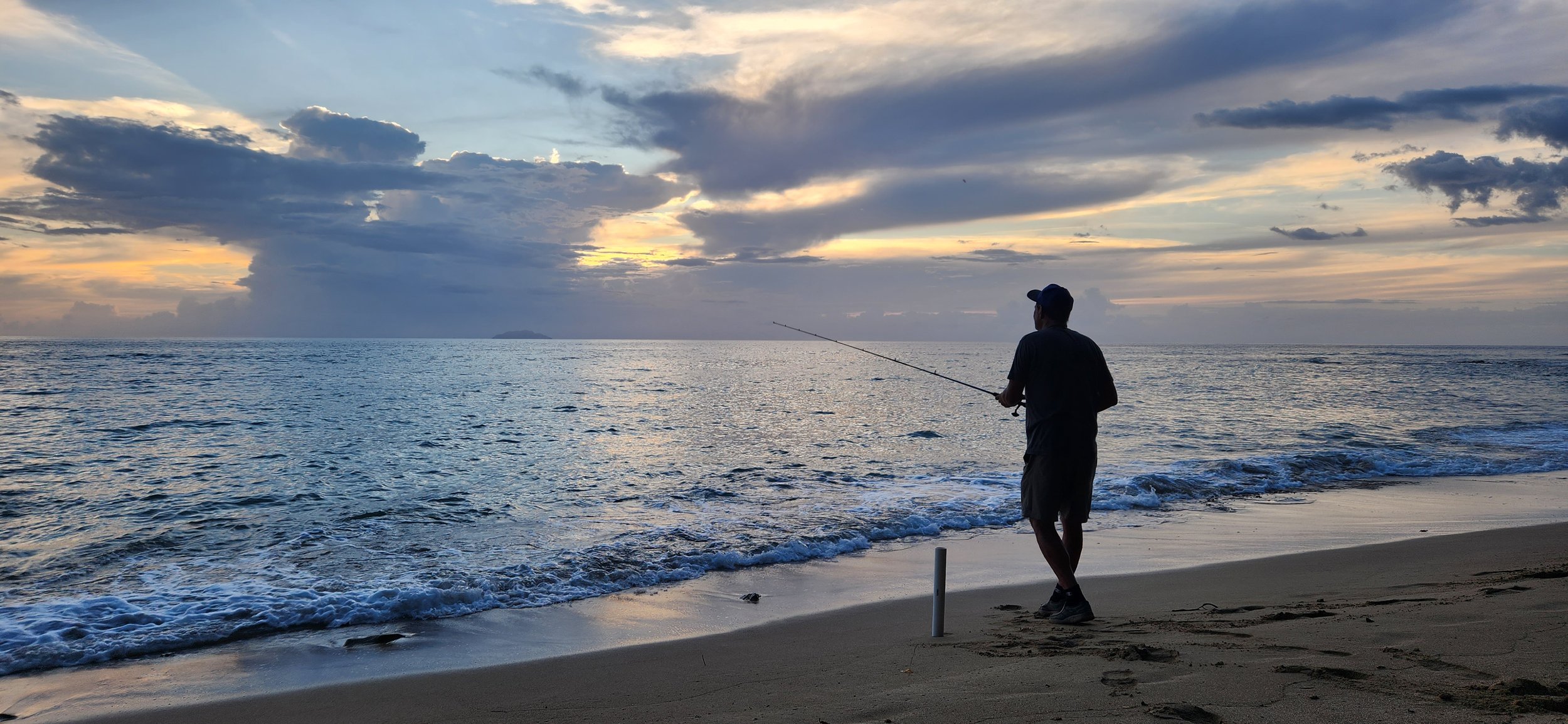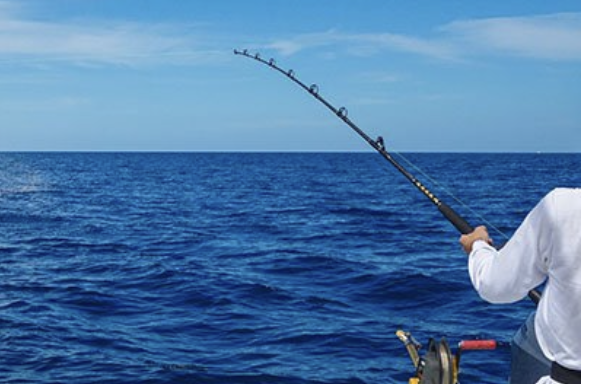
Let’s talk a little about the fish, the seasons, sustainable fishing, and Puerto Rico’s rich fishing heritage.
-
Pelagic fish get their name from the area that they inhabit called the pelagic zone. The pelagic zone is the largest habitat on earth with a volume of 330 million cubic miles. Different species of pelagic fish are found throughout this zone. Numbers and distributions vary regionally and vertically, depending on availability of light, nutrients, dissolved oxygen, temperature, salinity, and pressure.
Pelagic fish can be categorized as coastal and oceanic fish, based on the depth of the water they inhabit within the pelagic zone. Coastal pelagic fish inhabit sunlit waters up to about 655 feet deep, typically above the continental shelf. Examples of species include forage fish such as anchovies, sardines, shad, and menhaden and the predatory fish that feed on them. Oceanic pelagic fish typically inhabit waters below the continental shelf. Examples include larger fish such as swordfish, tuna, mackerel, and even sharks.
There is no distinct boundary from coastal to ocean waters so some oceanic fish become partial residents of coastal waters, often during different stages of their lifecycle. However, true oceanic species spend their entire life in the open ocean.
-
Puerto Rico has a long history of fishing, dating back to the indigenous Taíno people who fished for sustenance in the island's coastal waters. With the arrival of the Spanish colonizers in the late 15th century, commercial fishing began to play a larger role in the island's economy.
During the early colonial period, fishing was primarily a subsistence activity, with small-scale operations conducted by individual households. However, as the population grew and demand for fish increased, commercial fishing became more important. In the 18th and 19th centuries, Puerto Rico became a major supplier of salted fish to other parts of the Caribbean and Europe.
Puerto Rico became an unincorporated territory of the United States in 1898. The 20th century saw significant changes in Puerto Rico's fishing industry, with the development of new technologies and the growth of international markets. In the 1930s, the island's tuna canning industry began to take off, with large processing plants established in cities like Mayagüez and Ponce. The industry continued to grow throughout the mid-20th century, with Puerto Rican tuna becoming a major export to the United States and other countries.
However, the industry has faced challenges in recent decades, including overfishing, pollution, and competition from foreign imports. In the 1990s, the collapse of the island's shrimp fishery led to the closure of many processing plants and a decline in the industry overall. Today, commercial fishing remains an important part of Puerto Rico's economy, with a variety of species caught and sold, including snapper, grouper, lobster, and conch. The industry is regulated by the Puerto Rico Department of Natural Resources, which sets limits on catches and works to protect the island's marine resources.
-
Western Puerto Rico is a unique location where the Atlantic Ocean meets the Caribbean Sea. As a result, the region around Aguadilla/ Aguada/ Rincón exhibits a combination of ocean characteristics that make it distinct from other parts of the world. Here are some of the key ocean characteristics of western Puerto Rico:
•Water temperature: The Caribbean Sea is typically warmer than the Atlantic Ocean, with temperatures ranging from 25°C to 30°C. In contrast, the Atlantic Ocean in this region is cooler, with temperatures ranging from 20°C to 25°C. The mixing of these two bodies of water creates a unique temperature gradient in western Puerto Rico.
•Salinity: The Caribbean Sea has a lower salinity level than the Atlantic Ocean due to its proximity to the Amazon River, which carries freshwater into the sea. The mixing of these two bodies of water results in a range of salinity levels in western Puerto Rico.
•Marine biodiversity: The mixing of these two bodies of water creates a unique environment for marine life. The area is home to a diverse range of marine species, including coral reefs, sea turtles, dolphins, and whales.
•Ocean currents: The region is influenced by ocean currents from both the Atlantic Ocean and the Caribbean Sea. The Atlantic Ocean's Gulf Stream flows northward along the eastern coast of Puerto Rico, while the Caribbean Current flows eastward along the island's southern coast. The interaction between these currents can cause strong currents and riptides in some areas.
•Waves: The waves in western Puerto Rico are influenced by the prevailing winds and ocean currents. The Atlantic Ocean's waves are generally larger and more powerful than those in the Caribbean Sea. However, the waves can vary significantly depending on the location and time of year.
Overall, the unique combination of water temperature, salinity, marine biodiversity, ocean currents, and waves make western Puerto Rico a fascinating and diverse oceanic region.
-
Conjure up an image of the Caribbean, and it probably looks like the west coast of Puerto Rico. Here, you’ll find mangroves near the golden beaches, before turquoise waters lend themselves to productive reefs. From Aguadilla to Rincón through to Mayagüez and down to Boquerón, there’s a range of beauty and fishing grounds for anglers to hit up.
Some of the planet’s favorite fish are on offer in and around Puerto Rico. It’s time to get to know them. From the inshore shallows to the reefs, and all the way out to the deep waters of the Atlantic, there’s no shortage of prime hunting grounds full of trophy-sized monsters biting away at your line.
TARPON, SNOOK, and BONEFISH - Oh My! There are few inshore fisheries in the world as rich as Puerto Rico’s. The numerous lagoons and bays around the mainland and smaller islands offer a great haven for some tough-fighting creatures that every angler wants to catch. At the top of that list, Bonefish and Tarpon are hard to beat.
Both of these creatures require a lot of skill and patience to land. That’s why they’re so highly-rated among anglers the world over!
The Tarpon here can reach up to 150 pounds. If you’re looking for that dream “Silver King,” Puerto Rico is the place for it.
SNOOK AND JACKS Not far behind Bonefish and Tarpon on the inshore fishing bucket list are Snook and Jacks. Found in similar shallow waters, these creatures are also prized fish that will make you work hard to catch ‘em.
Unlike their spooky neighbors, these creatures are a little less picky. Heck, Jacks are sure to take anything that moves quickly in front of them! That means that you’ll get more hits than with the other two, so keep the fun going all day long.
WAHOO AND MAHI MAHI If you’re heading a few miles offshore, then two exciting and delicious creatures that are sure to be on your list are Wahoo and Mahi Mahi. Pelagic by nature, these creatures come by at different times of the year. They provide plenty of fun when trolling the open waters. And, thanks to that Yucatan current, you don’t have to go far to get them!
Just five miles out, you’ll find these strong beasts ready to take your bait. And boy will they make you work hard to reel ’em in! Don’t worry though, it’ll all be worth it as you head back to shore with a real treat for dinner. You’ll also have the added benefit of targeting them pretty much all around Puerto Rico, as they love the Caribbean and the Atlantic.
MARLIN AND SAILFISH If you thought it couldn’t get much better than 150 lb Tarpon, then wait until you see what the deep seas have to offer. Sailfish and Blue and White Marlin will get the pulses racing for any serious angler in Puerto Rico. Again, just a short trip from shore will see you come face-to-gills with these beasts, who put up some of the best battles you can have on a rod and reel.
Marvel as the Marlin leap out of the water and put on an acrobatic display to wriggle off your line. Or get ready to be dumbstruck as a stunning Sailfish dwarfs you and your pals once you hook one aboard. While fishing for these beauties isn’t for the faint of heart, it’s up there with one of the best experiences you can have when casting a line. And there are few places as good to target them than Puerto Rico.
That list should have already got you sold on the idea of a Puerto Rico fishing holiday. But, if not, there’s a long list of other creatures that you can target when here. We haven’t even started talking about the reefs that hold some of the most dazzling and delicious fish out there. Bottom fish for Snappers, Groupers, Mackerel, Barracuda, and many more, and you’re sure to land a treat.
Head offshore, and Tuna and Spearfish could also be on the menu. These migratory monsters promise a battle as good as Mahi and Marlin with the added bonus of some tasty meat to take back to shore!
Before going fishing anywhere, you’re going to want to know about the local rules and regulations. Certain species are catch-and-release only, such as Tarpon, Bonefish, and Billfish. Other fish are subject to seasons and size and bag limits.
If you’re chartering with Insurgent Cuisine, you will not need to have your own license. However, if you fish from shore or from your own vessel, you should have one. Unlike on most of the US mainland, tackle and bait stores don’t sell fishing licenses in Puerto Rico. You’ll need to go to one of the seven regional offices of the Department for Natural Resources
-
Wahoo Season: November-April. Wahoo range from 10-70 pounds. Average size Wahoo range from 25-35 pounds with several 40-50 pound fish around. You can expect to catch Kingfish, Barracuda and Blackfin Tuna when fishing for Wahoo.
Mahi Mahi Seasons: South Coast February-May. Mahi Mahi on the South Coast average 20-30 pounds. There is always a chance to get into the 40-50 and even 60-70 pound fish in this run. Typically these fish are caught on weedlines and currents.
Tuna Season: Tuna can be caught throughout most of the year. Blackfin Tuna average in the 25 pound range. Yellowfin aren't as common but are caught from 40- 80 pound range. Trolling, drifting over humps and ledges drifting live baits raises fish consistently. Schools of Yellowfin are often found nearby Whale Sharks, which is definitely a show not to be missed.
Snapper Season: _
Blue Marlin Season: June-November with the best months of the run being August-October. Average size Fish are between 150-250 pounds with 300-400 pound fish around. When fishing for Blue Marlin, there is always the possibility for White Marlin, Longbill Spearfish and Sailfish.
-
Sustainability is about the future. And it begins with all of us and the choices we make.
To learn more about sustainable fish and fishing, we encourage you to dive into (pun intended) the vast knowledge of Monterey Bay Aquarium: Speak up for Sustainability. [They also have some cool live cameras!].
-
More info coming soon
An Insurgent Cuisine Fishing Excursion is the ultimate destination for anyone looking to embark on a thrilling fishing trip, in a one-of-a-kind location, with experienced guides who know these waters. You can customize your experience and learn from the best. Deep sea fishing, reef fishing, slow pitch jigging, and flats angling – you name it, we have the knowledge, gear, and experience.
The waters of Puerto Rico are abundant with a variety of fish species; our charters will take you to the best places. We can head to Desecheo, down The Mona Passage, or stay closer to shore. We pride ourselves on providing the best fishing experiences and want to ensure you have a great time and catch plenty of fish. Will it be tuna? Or some wahoo and mahi mahi? Red snapper is always delicious too.
We’re excited to cast off with you!
Why insurgent fishing?
Why insurgent fishing?









